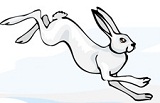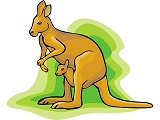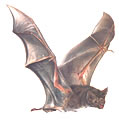Class Mammalia - Teacher's Guide
Note: Mammal orders and classification change, and some books may have different answers depending on how current the book are. How detailed the answers and descriptions are depends on you.
There are two possible ways to have your students complete the chart - they can do it as an individual or group project where they use their books and other resources to find the answers, or they treat this chart as notes and you can talk about each group, who pictures and discuss as they fill in the table. I use the Mammal Powerpoint Presentation with this chart because there are some fantasic images of animals and short video clips that the students enjoy. This method does take some time though, plan for at least two days and perhaps more because students will ask a lot of questions and share stories about their own animal encounters. Mammals are just a popular topic!
| Animal | Order | Description (special traits) |
Members |
 |
Monotremata | the only mammal that lays eggs, platypus are also the only mammals that are venomous | echidna (spiny anteater) |
 |
Artiodactyla | hoofed mammals with an ODD number of toes | sheep, pigs, bison, deer |
 |
Rodentia | gnawing mammals, incisors continue to grow throughout their lives | squirrels, rats, hamsters, ferrets |
 |
Lagomorpha | double row of incisors, hind legs adapted for hopping *trivia: pikachu (pokemon) is modeled after a pika |
hares, pika
|
 |
Carnivora | large canines, generally meat-eaters, the panda bear is an exception. Most carnivores are actually omnivores (bears, dogs, etc) | raccoon, dog/wolf, tiger, lion, fox, bears, badgers |
 |
Primate | opposable thumbs, large brains, have social groups, use tools | chimpanzee, human, gorilla, organgutan |
 |
Cetacea | aquatic mammals, blowhole, echolocation | dolphins, porpoises, whales |
 |
Proboscidea | have trunks, tusks, only found in Africa and Asia - two different species with slight differences in appearance (ear shape) | Asian Elephant African Elephant |
| Animal | Order | Description (special traits) | Members |
 |
Marsupiala | Young are born in an immature state and complete development in a pouch. Australia is home to all marsupials except the opossum | Kangaroo, koala, wallaby, tasmanian devil |
 |
Perissodactyla | Hoofed mammals with an even number of toes. The rhino is an endangered species, was hunted for its horn, which is actually tightly wound hair. |
Horses, zebras |
 |
Xenarthra (also edentata in some txts) also found as Order CINGULATA with xenarthra being a superorder See: Armadillo |
reduced or absent enamel on teeth, some have hardly no teeth at all (sloth) | sloth, anteater |
 |
Chiroptera | only flying mammals, the wings are actually skin stretched between their phalanges (fingers); also have echolocation for night hunting, some are important for flower fertilization (fruit bats) | vampire bat, fruit bat, etc. |
 |
Insectivora | Insect eating, digging mammals, teeth structure differs from rodents | shrew |
 |
Sirenia | Aquatic mammals, they do not have blowholes and are found near shorelines eating vegetation *the name Sirenia comes from sailors who thought the animals were the sirens from greek mythology* manatees are endangered because they are often hit by boats and they have very little fear of humans |
manatees in N. Ameria dugongs in Japan |
These photos were in the ppt presentation, if students were paying attention, they might remember their names: |
|||

